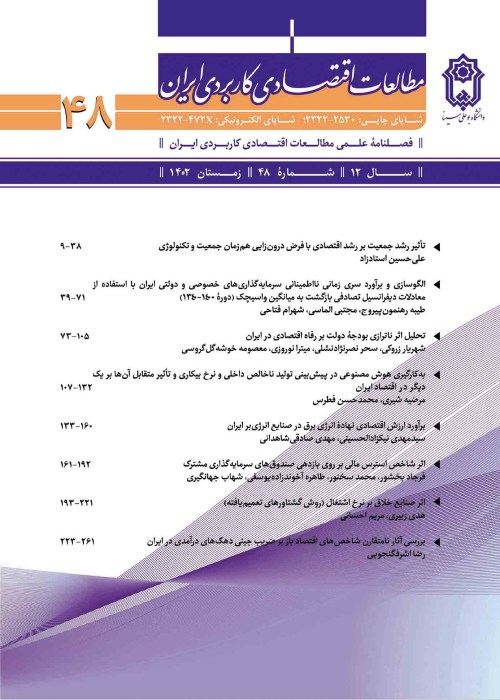Measurment of Statistical Accuracy between Commodity Balance (CB) and CHARM Methods in the Estimation of Regional Input-Output Tables (RIOTs); The Case Study of Hormozgan Province
Author(s):
Abstract:
In developing countries, planning is accepted by economic experts as well as by decision makers as one of the essential tools to promote growth and development both at national and regional levels. Because the Regional Input-Output Tables (RIOTs) can be provided the great sectoral detail from the economy of each region, they are most important for regional planning as well as for regional analysis. But the application of input-output analysis for analytical purposes in regional economic levels is often get into trouble by the fact that most statistical centers provide input-output tables only at national level and the task of constructing a RIOT is therefore left to the individual researcher. The construction of the survey-based RIOTs can be complex, expensive and time consuming. Since the 1950s regional analysts have introduced non-survey based methods like Location Quotients (LQ, such as , , , , , , and ), Commodity Balances (CB) and Cross Hauling Adjusted Regionalization Method (CHARM) to estimate Regional Input-Output Coefficients (RIOCs) and RIOTs. One of the most important shortcomings of LQ and CB methods which remained unsolved for more than six decades is underestimation of regional imports and exports on account of ruling out of Cross-Hauling which leads to the overestimation supply multipliers. Cross-hauling is the export and import of the same commodity and in Location Quotients and Commodity Balances it is assumed not to exist. In 2009, the CB method has modified which is known as the CHARM method, can solve the problem of underestimation. By identifing the heterogeneity of commodities as the main cause of cross-hauling, Kronenberg try to modify CB method. CHARM is a pure nonsurvey method and related to the traditional commodity balance approach, but, it requires fewer restrictive assumtions and has a better theoretical foundation. This method is suitable for environmental and other applications where the focus is on the overall supply of goods, regardless of their source.
This paper followes two main
The research findings for Hormozgan Province with respect to supply multiplier matrix show that the degree of accuracy of the supply multiplier matrix of the CHARM method in all the five statistical methods are much closer to official figures than the CB method. In the other words the statistical error of CHARM method is much less than CB method in supply multipliers. In addition to, between three sources of error in CHARMs estimates, heterogeneity errors have the highest share of statistical errors in Hormozgan Province.
This paper followes two main
Objectives
One the application of CB and CHARM methods and the measurement of their statistical errors. Second is the decomposition of the derived statistical errors into scale error, technology error and the heterogeneity error. The quantification of these objectives is analysed with the two folloing questions: are the supply multipliers derived the CHARM method out perform the supply multipliers better than from the CB method? And which one of the three decomposed errores (scale error, technology error and the heterogeneity error) has more share in the total statistical errors? For the applications of the CHARM and CB methds we have used the following data. First- on the basis of the survey-based National Input-Output Table (NIOT) of 1380, that we have updated it for the year 1382 respectively. Second- the regional sectoral intermediate inputs and sectoral outputs of Hormozgan provience are directly taken from the regional accounts for the year 1382. Third- we used the survey-based RIOT of Hormozgan provience for the year 1382. In order to make the applications of two methods, we have aggregated all the data into seven secters: Agriculture, mining, agro-based industries, other industries, water, electricity and gas, construction and services. In order to evaluate the stimated RIOTs derived from the two methods whit the corresponding true figures, we have used five conventional statistical Methods
MAD, Theil, STPE and WAD.The research findings for Hormozgan Province with respect to supply multiplier matrix show that the degree of accuracy of the supply multiplier matrix of the CHARM method in all the five statistical methods are much closer to official figures than the CB method. In the other words the statistical error of CHARM method is much less than CB method in supply multipliers. In addition to, between three sources of error in CHARMs estimates, heterogeneity errors have the highest share of statistical errors in Hormozgan Province.
Keywords:
Language:
Persian
Published:
Quarterly Journal of Applied Economics Studiesin Iran, Volume:6 Issue: 22, 2017
Pages:
33 to 58
magiran.com/p1720366
دانلود و مطالعه متن این مقاله با یکی از روشهای زیر امکان پذیر است:
اشتراک شخصی
با عضویت و پرداخت آنلاین حق اشتراک یکساله به مبلغ 1,390,000ريال میتوانید 70 عنوان مطلب دانلود کنید!
اشتراک سازمانی
به کتابخانه دانشگاه یا محل کار خود پیشنهاد کنید تا اشتراک سازمانی این پایگاه را برای دسترسی نامحدود همه کاربران به متن مطالب تهیه نمایند!
توجه!
- حق عضویت دریافتی صرف حمایت از نشریات عضو و نگهداری، تکمیل و توسعه مگیران میشود.
- پرداخت حق اشتراک و دانلود مقالات اجازه بازنشر آن در سایر رسانههای چاپی و دیجیتال را به کاربر نمیدهد.
In order to view content subscription is required
Personal subscription
Subscribe magiran.com for 70 € euros via PayPal and download 70 articles during a year.
Organization subscription
Please contact us to subscribe your university or library for unlimited access!


